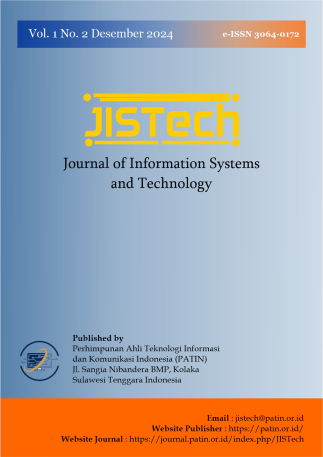Pengembangan Sistem Informasi Seleksi Penerimaan Bantuan Langsung Tunai Menggunakan Metode K-Nearest Neighbor
Keywords:
Cash Transfer Assistance, K-Nearest Neighbor, Information System, BLT Recipient SelectionAbstract
The implementation of the Cash Transfer Assistance (BLT) program in Indonesia aims to assist economically disadvantaged communities, especially during crises such as the pandemic. However, the selection process for BLT recipients often faces challenges related to accuracy and efficiency, particularly in determining eligible recipients based on various economic and social criteria. This research develops an information system based on the K-Nearest Neighbor (K-NN) method to address these issues. The system is designed to classify BLT candidates by considering several variables, such as family income, number of dependents, employment status, housing conditions, and family health. The optimal K value was determined through trial and error to achieve the highest accuracy. The system was tested using both training and testing data, and the evaluation results showed an accuracy rate of 85%. This information system not only processes data quickly but also provides transparent and objective results, making it useful for village authorities to efficiently select BLT recipients. By implementing the K-NN algorithm, this system is expected to offer a practical solution for village governments in improving the accuracy of aid distribution to eligible communities.
References
[1] Selviana, I. Akib, and Risfaisal, “Bantuan Langsung Tunai,” Equilib. Pendidik. Sosiol., vol. III, no. 2, pp. 126–135, 2016.
[2] I. Sofi, “Efektivitas Bantuan Langsung Tunai Dana Desa Dalam Pemulihan Ekonomi Di Desa,” Indones. Treas. Rev., vol. 6, no. 3, pp. 247–262, 2021.
[3] R. Bahtiar, “Implementasi Data Mining Untuk Prediksi Penjualan Kusen Terlaris Menggunakan Metode K-Nearest Neighbor,” J. Inform. MULTI, vol. 1, no. 3, pp. 203–214, 2023.
[4] A. Aisyah and S. Anraeni, “Analisis Penerapan Metode K-Nearest Neighbor (K-NN) pada Dataset Citra Penyakit Malaria,” Indones. J. Data Sci., vol. 3, no. 1, pp. 17–29, 2022, doi: 10.56705/ijodas.v3i1.22.
[5] E. S. Susanto, K. Kusrini, and H. Al Fatta, “Prediksi Kelulusan Mahasiswa Magister Teknik Informatika Universitas Amikom Yogyakarta Menggunakan Metode K-Nearest Neighbor,” Respati, vol. 13, no. 2, pp. 67–72, 2018, doi: 10.35842/jtir.v13i2.260.
[6] J. Saputra, Y. Sa, V. Yoga Pudya Ardhana, and M. Afriansyah, “RESOLUSI : Rekayasa Teknik Informatika dan Informasi Klasifikasi Kematangan Buah Alpukat Mentega Menggunakan Metode K-Nearest Neighbor Berdasarkan Warna Kulit Buah,” Media Online, vol. 3, no. 5, pp. 347–354, 2023.
[7] A. Paliling and M. N. Sutoyo, “Combination of The MADM Model Yager and k-NN to Group Single Tuition Payments,” Ilk. J. Ilm., vol. 15, no. 2, pp. 326–334, 2023.
[8] A. Sumiah and N. Mirantika, “Perbandingan Metode K-Nearest Neighbor dan Naive Bayes untuk Rekomendasi Penentuan Mahasiswa Penerima Beasiswa pada Universitas Kuningan,” Buffer Inform., vol. 6, no. 1, pp. 1–10, 2020.
[9] Kurnia Fitra, Kurniawan Jhoni, Fahmi Ichsan, and Monalisa Siti, “Klasifikasi Keluarga Miskin Menggunakan Metode K-Nearest Neighbor Berbasis Euclidean Distance,” Semin. Nas. Teknol. Inf. Komun. dan Ind., no. November, pp. 230–239, 2019.
[10] M. Muchtar, “Classification of Chicken Meat Freshness Based on YCbCr Color and Fractal Features Using KNN Method,” semanTIK, vol. 10, no. 1, p. 43, 2024, doi: 10.55679/semantik.v10i1.47238.
[11] J. I. Kartika, E. Santoso, and Sutrisno, “Penentuan Siswa Berprestasi Menggunakan Metode K-Nearest Neighbor dan Weighted Product (Studi Kasus: SMP Negeri 3 Mejayan),” J. Pengemb. Teknol. Inf. dan Ilmu Komput., vol. 1, no. 5, pp. 352–360, 2017.
[12] M. Sutoyo, “Rancang Bangun Aplikasi Untuk Memprediksi Status Gizi Balita,” Klik - Kumpul. J. Ilmu Komput., vol. 5, no. 2, p. 136, 2018, doi: 10.20527/klik.v5i2.140.
[13] M. T. Hidayat and R. H. Laluma, “Penerapan Metode K-Nearest Neighbor Untuk Klasifikasi Gizi Balita,” Infotronik J. Teknol. Inf. dan Elektron., vol. 7, no. 2, p. 64, 2022, doi: 10.32897/infotronik.2022.7.2.1702.







